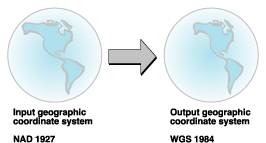Moving your data between coordinate systems sometimes includes transforming between the geographic coordinate systems.

Because geographic coordinate systems contain datums that are based on spheroids, a geographic transformation also changes the underlying spheroid. There are several methods, which have different levels of accuracy and ranges, for transforming between datums. The accuracy of a particular transformation can range from centimeters to meters depending on the method and the quality and number of control points available to define the transformation parameters.
A geographic transformation is always defined in a particular direction. The picture above illustrates a transformation that converts from North American Datum (NAD) 1927 to World Geodetic System (WGS) 1984. When working with geographic transformations, if no mention is made of the direction, an application or tool like ArcMap will handle the directionality automatically. For example, if converting data from WGS 1984 to NAD 1927, you can pick a transformation called NAD_1927_to_WGS_1984_3 and the software will apply it correctly.
(ArcMap automatically loads one geographic transformation. It's designed for the lower 48 states of the United States and converts between NAD 1927 and NAD 1983.)
A common transformation in North American data is between NAD 1983 and WGS 1984, such as between the GCS_North_American_1983 and GCS_WGS_1984 geographic coordinate systems. See ESRI Support KnowledgeBase article 24159 for tips on how to determine which transformation to use between NAD 1983 and WGS 1984.
A geographic transformation always converts geographic (latitude–longitude) coordinates. Some methods convert the geographic coordinates to geocentric (X,Y,Z) coordinates, transform the X,Y,Z coordinates, and convert the new values back to geographic coordinates.

These include the Geocentric Translation, Molodensky, and Coordinate Frame methods.
Learn about equation-based transformation methods.
Other methods, such as NADCON and NTv2, use a grid of differences and convert the longitude–latitude values directly.
Learn about grid-based transformation methods.